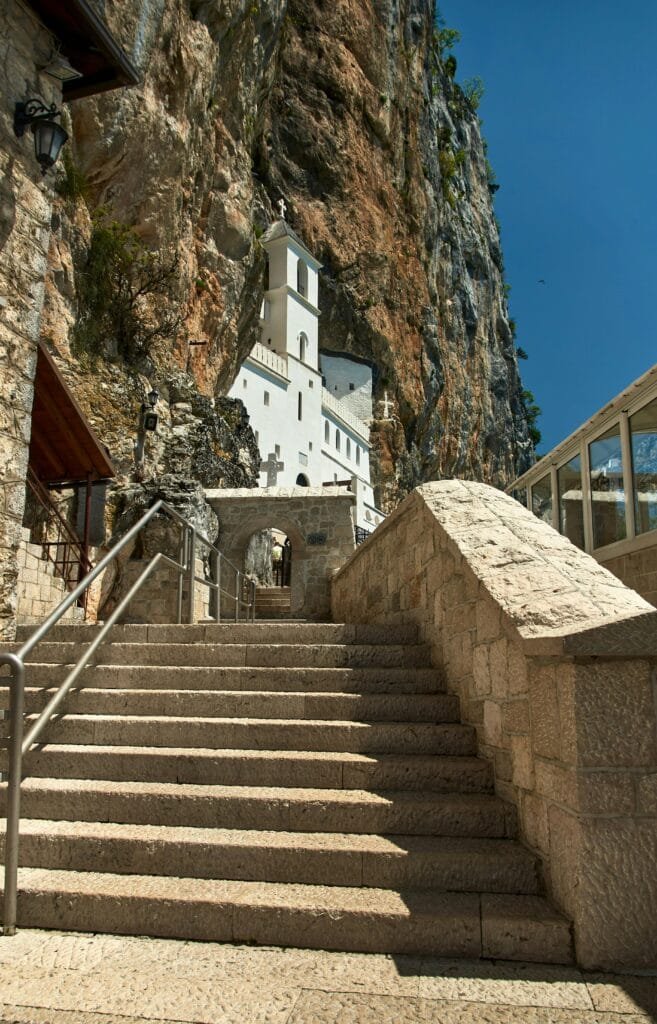Table of Contents
Introduction to Ostrog Monastery

Perched high on a rocky cliff in Montenegro, Ostrog Monastery is a spiritual and architectural marvel that attracts thousands of pilgrims and tourists each year. Dedicated to Saint Basil of Ostrog, this Orthodox Christian monastery is carved into the sheer rock face, blending seamlessly with its natural surroundings.
Known for its miraculous relics and breathtaking views of the Zeta Valley, Ostrog Monastery is a place where faith, history, and natural beauty converge. Whether you seek spiritual solace or an awe-inspiring adventure, this sacred site promises an unforgettable experience.
History of Ostrog Monastery
Ostrog Monastery was founded in the 17th century by Saint Basil of Ostrog, a revered figure in the Orthodox Christian faith. He chose this remote location to establish a place of worship and refuge, far from the political and religious turmoil of the time.
Throughout its history, the monastery has survived numerous challenges, including wars and natural disasters. Its resilience has made it a symbol of faith and perseverance for Montenegrins and believers worldwide. Today, it remains one of the most significant pilgrimage sites in the Balkans.
Architecture of Ostrog Monastery
The monastery’s architecture is a testament to human ingenuity and devotion. Built directly into a vertical cliff, it appears to be a natural extension of the rock face. The complex is divided into two main sections: the Upper Monastery and the Lower Monastery.
The Upper Monastery

The Upper Monastery houses the Church of the Presentation and the Church of the Holy Cross. Artists adorned its walls with frescoes painted directly onto the rock, creating a unique blend of natural and artistic beauty. People keep the relics of Saint Basil here, believing in their miraculous healing powers, which makes it the spiritual heart of the monastery.
The Lower Monastery

Located at the base of the cliff, the Lower Monastery includes several churches and facilities for pilgrims, such as dormitories and dining areas. A steep, scenic trail connects it to the Upper Monastery, offering stunning views along the way.
The Spiritual Significance of Ostrog Monastery
Ostrog Monastery is a sacred site for Orthodox Christians, but its spiritual appeal transcends religious boundaries. Pilgrims from various faiths visit the monastery, drawn by its reputation for miracles and healing. Many believe that the relics of Saint Basil can cure illnesses and bring blessings, leading to an enduring tradition of prayer and veneration.
The monastery also serves as a symbol of unity, attracting visitors from diverse backgrounds who seek solace and inspiration.
Visiting Ostrog Monastery
How to Reach the Monastery
Ostrog Monastery is located near the town of Danilovgrad, approximately 50 kilometers from Podgorica, Montenegro’s capital. Visitors can reach the monastery by car, taxi, or organized tours. The final stretch involves a steep, winding road, followed by a short hike to the Upper Monastery.
Map Location
Best Times to Visit
The monastery is open year-round, but spring and early autumn offer the most pleasant weather for exploring its outdoor areas. Religious holidays, such as Saint Basil’s feast day on May 12, draw large crowds, creating a lively but crowded atmosphere.
Exploring the Surroundings
The area around Ostrog Monastery offers breathtaking views of the Zeta Valley and opportunities for hiking and nature exploration. Scenic trails wind through the rugged landscape, providing a peaceful retreat for those who wish to connect with nature.
Tips for First-Time Visitors
- Dress Modestly: The monastery is a religious site, so visitors should wear modest clothing that covers their shoulders and knees.
- Stay Hydrated: The hike to the Upper Monastery can be strenuous, especially in hot weather, so bring water and wear comfortable shoes.
- Respect Local Customs: Be mindful of the spiritual atmosphere and avoid loud conversations or disruptive behavior.
The Legacy of Saint Basil of Ostrog
Saint Basil of Ostrog, the founder of the monastery, people venerate as a miracle worker and protector of Montenegro. His relics, enshrined in the Upper Monastery, inspire faith and devotion. Countless stories link his name to healing and answered prayers, solidifying his legacy as a spiritual beacon.
Conclusion
Ostrog Monastery is a place where spirituality and natural beauty come together in perfect harmony. Its awe-inspiring architecture, deep historical roots, and reputation for miracles make it a must-visit destination for anyone exploring Montenegro. Whether you come for prayer, reflection, or simply to marvel at its breathtaking setting, The Monastery offers an experience that will leave a lasting impression.
FAQs
1. Why is Ostrog Monastery so famous?
Ostrog Monastery is renowned for its miraculous relics, unique cliffside architecture, and role as a major pilgrimage site in the Balkans.
2. Can non-religious visitors explore the monastery?
Yes, Ostrog Monastery welcomes visitors of all faiths, offering a peaceful and inspiring experience for everyone.
3. What is the best time to visit Ostrog Monastery?
Spring and early autumn provide the best weather for exploring the monastery and its surroundings.
4. How long does it take to explore the monastery?
A visit typically takes 2-3 hours, including the hike between the Upper and Lower Monasteries. Additionally, the journey allows visitors to experience the monastery’s stunning surroundings
5. Are there accommodations near the monastery?
Yes, basic accommodations are available for pilgrims, and nearby towns offer a range of hotels and guesthouses.
To explore more details about the Ostrog Monastery in Montenegro, you can visit the official website at Visit Montenegro’s page on Ostrog Monastery

